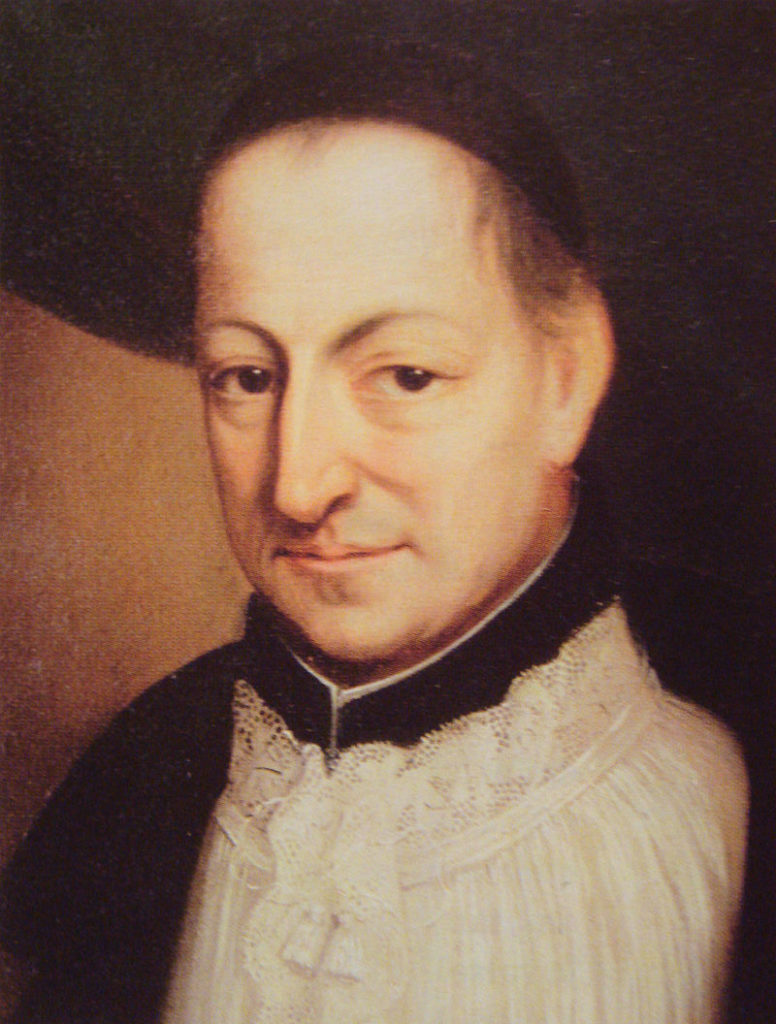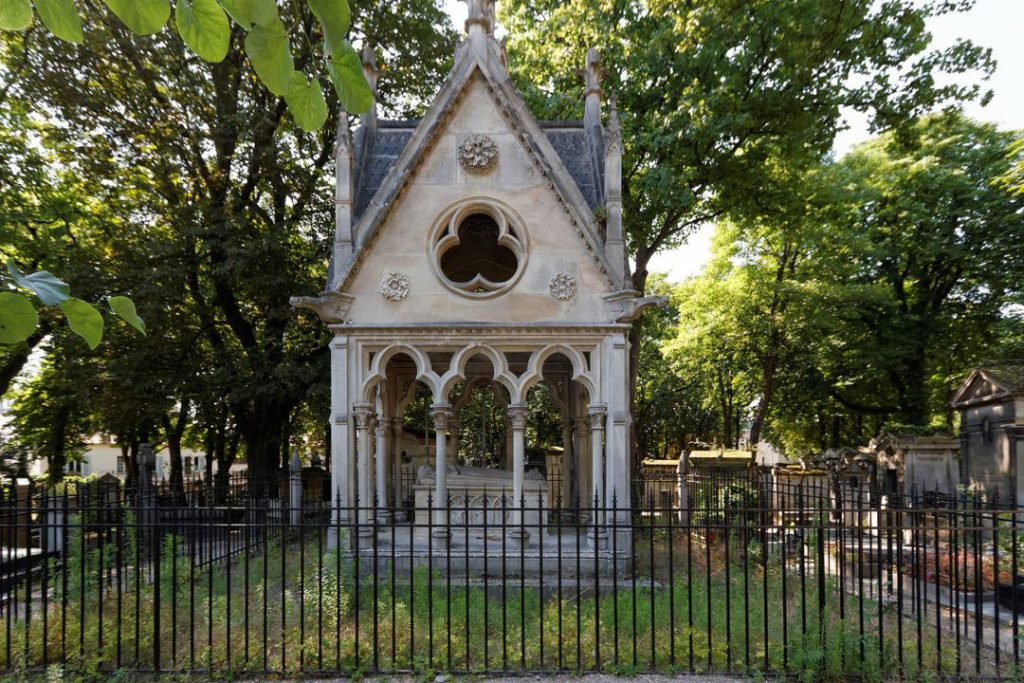Our walk through le Marais done, it was time to break for lunch and we’d let David choose the restaurant. I believe it was the Bistrot des Vosges and while the meal was fine, the service was sadly below par. David told us he’d never had such a disappointing experience there. I can’t tell you whether the confusion arose from the wait staff or in the kitchen but it was distracting enough to have erased all memory of the meal itself – at least for me. (And my apologies to the Bistrot des Vosges if I also erased the right restaurant from my memory.)
The most famous cemetery in Paris.
The focus of the afternoon of our Downie day was a walk through P├©re-Lachaise – the largest (44 hectares) and most famous cemetery in Paris – although it was outside the city when it opened in 1804 the same year as Napol├®on Bonaparte’s coronation. Commonly called P├©re Lachaise, its official name has remained unchanged since its opening – Le Cimeti├©re de l’Est (Eastern Cemetery).
Today,┬ĀP├©re Lachaise is in the 20th arrondissment which has been its designated neighborhood since the city’s expansion from its original 12 arrondissments to the current 20 in 1860. It was at this time that the spiral shape we see today replaced the older system that had sited arrondissements 1-9 on the Right Bank and 10-12 on the Left Bank.
(The cemetery is toward the upper right and marked by the red pin in this satellite shot from Google maps. For reference, the traffic circle at the bottom left is the Place de la Bastille and just above it and a bit farther left is the Place des Vosges.)
It would have been easy to take the M├®tro but David suggested we ride the bus. This way, rather than passing under the city, we’d actually see some of Paris and on the way, we would have a bit more time to learn about the cemetery’s history, how it came to be the place the families of the dead wanted them to be, and a bit about the man for whom it is named – Fran├¦ois d’Aix de la Chaise.
(Fran├¦ois d’Aix de la Chaise succeeded the deceased P├©re {Father} Ferrier in 1675 as confessor to King Louis XIV ŌĆō a delicate but influential position he held for thirty-four years. Lachaise was worldly and ambitious and he is sometimes ascribed a significant role in some of the actions of the King.┬Ā┬Ā
For example, Louis XIV believed in the principle of cuius regio, eius religio or “whose realm, his religion” meaning that a kingdom should follow the religion of its king. Thus, in 1685 Louis revoked the Edict of Nantes {signed in 1598 by his grandfather Henri IV} replacing it with the Edict of Fontainebleu which made practicing Protestantism illegal. The degree to which Louis made this decision independently or was influenced by Lachaise or by his second wife Fran├¦oise d’Aubign├® more commonly known as Madame de Maintenon {a marriage Lachaise is reputed to have facilitated} is a subject of historical debate.
[Portrait of P├©re Lachaise – Wikimedia – Public Domain.]
Certainly, as Louis’ confessor, Lachaise was well acquainted with the former’s propensity for profligacy. Kings typically had official mistresses but Louis was more active than most. For example, there was his long affair with Madame de Montespan who replaced the king’s first mistress, Louise de la Valli├©re. In 1669, she gave birth to the first of seven children Louis fathered while she was still married to the Marquis de Montespan.┬Ā
Some believe that the breadth of Lachaise’s knowledge about Louis enabled him to convince the king to purchase the property then known as Mont Louis to serve as a retreat for Paris’ Jesuit brothers. Lachaise was also able to convince Louis to build him a small ch├óteau there that became the priest’s home until his death in 1709.┬Ā
It’s perhaps a bit ironic that P├©re Lachaise is not buried in the cemetery that bears his name. He is interred in the Church of Saint-Paul-Saint-Louis that’s barely a block from the flat Pat and I rented in Le Marais.)
The decision to name the cemetery for P├©re Lachaise was, in fact, a marketing ploy. Early on, the developers of the cemetery discovered that they had some obstacles to overcome if they were to attract customers. First, the grounds occupied a hill that, at the time, was some distance outside the city and the travel and effort needed to be able to visit one’s deceased relatives diminished its appeal. Second, after the Revolution French law required that all municipal cemeteries must be open not only to all sects, creeds, and religions but to agnostics and atheists as well. This meant the ground couldn’t be consecrated by the Jesuits or any other order. And finally, its bureaucratic sounding name, Cimeti├©re de l’Est, lacked any sort of charisma.
Early on, only a handful of families were choosing to inter their loved ones in the new cemetery so the developers hit upon a two-step solution. Step one was to rename it for the land’s one time resident and Louis XIV’s confessor, P├©re Lachaise thus conferring upon it at least an aura of piety.
But they knew the cemetery needed more than simply a more appealing appellation so their next contrivance was to relocate a number of celebrated people who, by their mere presence, might make the cemetery a fashionable choice. According to Downie’s book, “The first celebrity corpses whisked to the cemetery were in fact those of the luckless abbot Ab├®lard and his pupil H├®lo├»se, the twelfth-century lovers whose tragic tale of emasculation (his) and enforced separation (mutual) was the rage among early 1800s Romantics.” (I’ll have more on their story when we reach their rather spectacular tomb seen in the photo below.)
Ab├®lard and H├®loise were soon followed in turn by Louise de Lorraine the widow of King Henri III (to appeal to Royalists), Moli├©re and La Fontaine (to appeal to intellectuals and artists), and, as I mentioned in this post, Beaumarchais. Here’s how Downie describes the success of their efforts:.
Though business was slow at first the twin ploys of the Jesuit’s name and the famous transplanted skeletons eventually worked. By the 1810s┬ĀP├©re-Lachaise had become the resting place for families of high social standing or aspiration, those, in other words, with the money to buy a perpetual concession and build a monumental tomb. People spoke of the cemetery’s most desirable neighborhoods, paralleling them to Paris’s beaux quartiers. That explains why the roster of nineteenth- and twentieth-century marquee names with a slice of┬ĀP├©re-Lachaise is a Who’s Who of France.
Even today, the look of the older sections of P├©re-Lachaise with its narrow winding paths mirrors the look of old Paris. This might not have been the case had it not been for the above-mentioned concession┬Ā├Ā perp├®tuit├®┬Ā(perpetual grant). As the cemetery grew, the owners of these grants prevented proposed design alterations that would have imposed or tried to impose a more grid like structure on the entire cemetery (an arrangement that would have no doubt pleased Baron Haussman – though he is entombed in one of the cemetery’s older sections).
While any list of the interred would be mainly French, it isn’t exclusively so. Here’s a short list of names of people buried in P├©re-Lachaise all or nearly all of whom should be somewhat familiar to all of you (even if they’ve only become familiar to you through reading this blog):.
Pierre Ab├®lard┬Āand H├®lo├»se d’Argenteuil, Guillaume Apollinaire, Jean-Pierre Aumont, Honor├® de Balzac, Pierre-Augustin Caron de Beaumarchais, Judah P Benjamin, Sarah Bernhardt, Georges Bizet, Gustave Caillebotte, Maria Callas, Claude Chabrol, Fr├®d├®ric Chopin, Colette, Camille Corot, Eug├©ne Delacroix, Paul Dukas, Isadora Duncan, Max Ernst, Jean de La Fontaine, Georges-Eug├©ne Haussmann, Jean-Auguste Ingres, ├ēdouard Lalo, Marcel Marceau, Georges M├®li├©s, Amedeo Modigliani,┬ĀMoli├©re, Yves Montand, Jim Morrison, Max Oph├╝ls,┬Ā├ēdith Piaf, Camille Pissarro, Francis Poulenc, Marcel Proust, Jean Rollin, Edmond James de Rothschild, Gioachino Rossini, Simone Signoret, Gertrude Stein, Alice B Toklas, Oscar Wilde, and Richard Wright.
One of the more recent graves added was that of Bernard Verlhac. Verlhac was a cartoonist known as Tignous who was killed in the January 2015 shooting at the French satirical magazine Charlie Hebdo.
If you’re curious, you can find a more comprehensive list on this Wikipedia page. My photo album has photos of the graves of the people highlighted in red font as well as some random pictures I took while wandering the cemetery. And, if you can’t visit the cemetery yourself, and you’d like to see some photos of a few other remarkable graves in P├©re-Lachaise, this is a terrific website to visit.
Note: In keeping with my 2022-2023 reformation of the blog into shorter entries, backdated to maintain their sequence, any comments on this post might pertain to its new configuration. See the full explanation in the post Conventions and Conversions.



Zounds! This is a book!! Great job, Todd… and merci for the kind words. –dd
David – You and Alison earned the kind words. And yes, writing book length reports on my travels is my inclination. I always hope people have groaned (or laughed) a bit from my puns and that they feel they’ve learned something from whatever stimulated my interest on that specific trip.
Thanks for the memories, as Bob Hope sang to Shirley Ross in “The Big Broadcast of 1938.” We’ve visited P├©re-Lachaise twice, most recently last year, when (as promised) we left behind some of the ashes of our late friend Eric at Piaf’s grave (the rest ended up in front of what was once Cafe Conti on Rue de Buci and along the Seine; he would have appreciated that). Not wanting to be mistaken for terrorists, we were obliged to do all that surreptitiously, which proved to be an adventure in itself.
And thanks to you for
Galettes for lunch and then, châteaux sur la Seine
P├©re-Lachaise and sepulchers of many famous men
How lovely it was
Someday, I will have to hear from you the full story of the adventure with Eric’s ashes. My interest is piqued.